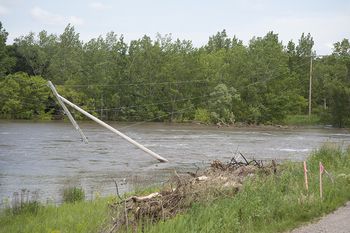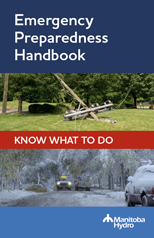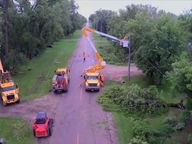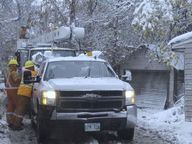Severe weather can develop without warning, affect your power supply, and create dangerous situations.
Emergency Preparedness Handbook
The information in this handbook is offered as a tool to help you plan your personal emergency response.
- Download the Emergency Preparedness Handbook (PDF, 2.1 MB)
Wind storms
If you see a tree touching a power line, call 911 or your local emergency services immediately.
High wind conditions can push over hydro poles and cause trees to contact power lines. Stay at least 10 metres away from power lines, trees, or anything they may be touching – including puddles. Any tree branches touching a power line may still be energized.
July 5, 2016 Outage Restoration — Altona area, Manitoba
On July 4, 2016, a major windstorm near Altona, Manitoba took down trees, grain bins, and wreaked havoc on power in the area. Here’s how our crew responded.
Winter storms
A winter storm can strike quickly, so plan ahead.
During a power outage, stay calm. Your house will remain warm for several hours. If you have an alternate heat source, use it before the house cools, and maintain adequate ventilation. Consider if a backup electric generator would be a good choice for your home or business.
Report your outage online or call 204-480-5900 (Winnipeg) or 1-888-624-9376 (toll-free).
Storm Restoration – October 11, 2019
On October 11, 2019, approximately 150,000 customers experienced outages. Our crews worked to restore as many as they could until the storm continued the next day.
Ice storms
When heavy snowstorms sweep through an area, ice can build up on power lines and cause flickering or power outages.
- Stay clear of low or sagging power lines. Travelling under these lines can be dangerous. Downed power lines may be energized so stay at least 10 metres away from the power lines or anything they may be touching.
- If you see excessive ice build-up on a section of lines, leaning or snapped poles, or downed lines, call us any time at 204-480-5900 (Winnipeg) or 1-888-624-9376 (toll-free).
Flooding
Spring run-off flooding may develop slowly but heavy rain can cause flash floods in lowland areas and basements. We disconnect electrical service in flooded areas.
Smart Ideas: Flood safety
Stay safe around electricity and natural gas during a flood. Learn what to do before, during, and after flooding in your home.
If an electrical or natural gas emergency occurs, flood-related or otherwise, call 911 or your local emergency services immediately.
What to do and not to do
Before a flood:
- Make sure your sewer backwater valve and sump pump work to prevent a backup.
- Move electrical equipment such as TVs, stereo, and computers, out of your basement to an upper floor.
- If your basement is dry, turn off the main power switch.
- Check with us if your natural gas service should be shut off.
During a flood:
- Watch for submerged poles and low-hanging power lines if travelling by boat.
- Be aware that water currents can change quickly as floodwater levels rise and fall.
- Avoid standing water as underground or downed power lines can carry an electric charge.
- Do not travel after dark unless it is an emergency as power lines are almost impossible to see.
If your property, building, or home floods, do not attempt to turn off the power yourself. Call us any time at 204-480-5900 (Winnipeg) or 1-888-624-9376 (toll-free) to disconnect the power.
After a flood:
- Do not enter any buildings that may not have had the power disconnected, and are still under water or were flooded.
- Call us any time at 204-480-5900 (Winnipeg) or 1-888-624-9376 (toll-free) to disconnect the power.

Overhead power lines clearance can be very low in the floodwater or hydro poles may be damaged in a flood.
Even if your building did not suffer water damage, the interior structure may be wet. Electricity can move through water or wet flooring and cause severe injuries or death. Even a small amount of water can be dangerous.
A licensed electrician should replace and test all wiring, outlets, baseboard heaters, and other electrical hardware that was in contact with floodwater before your power is restored.
A licensed heating contractor should inspect any natural gas appliances that were in contact with floodwater to see if they must be replaced.
Read more about flooding:
- Canadian Red Cross website
- Government of Canada Flood Ready website
- Province of Manitoba Flood Information website
- City of Winnipeg EmergWeb Flood website




